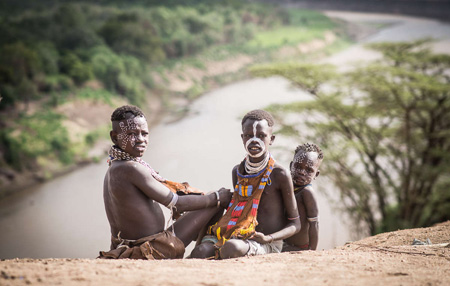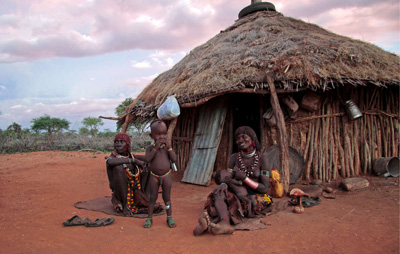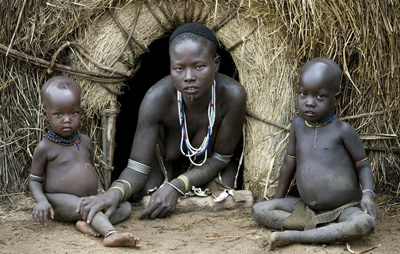| English Page |
Kenya: UN says Lake Turkana is endangered |
 |
 |
| 25 February 2019 | ||||||
UNESCO added Kenya’s Lake Turkana to its World Heritage Site Endangered List in June, a sign it believes the iconic lake’s survival is at risk
Experts believe it is drying up largely because of the Gibe III dam , which lies upstream in Ethiopia and was completed in 2016. For the eight different tribes of Ethiopia’s Omo valley region, the Gibe III dam and related sugar plantations project have already proved devastating. The dam has enabled local authorities to syphon off water from the Omo river to irrigate vast sugar plantations. Forcibly evicted from their land, many of the country’s tribespeople have lost not only their homes but an entire way of life. The dam has ended the natural flood they depended on for flood retreat agriculture as well as depriving them of access to the river for fishing and for growing their crops. Survival has received disturbing reports that tribal peoples are suffering from hunger and continue to suffer abuse and harassment if they speak out about the situation. Many communities are under pressure to relocate to government villages, a policy that most oppose. The dam is also causing problems for the thousands of tribal peoples in northern Kenya who live around Lake Turkana and who fish its waters for their livelihood.
According to Ikal Ang’elei, director of the NGO Friends of Lake Turkana which has campaigned for years against the Gibe III dam: “The lives of local communities now hang in the balance given that their main sources of livelihood are facing extinction. This decision by the UNESCO World Heritage Committee should serve as a notice to Ethiopia to cancel any further dams planned on the Omo River.” As early as 2010, one such expert predicted that the dam would reduce the lake’s inflow by some 50% and would cause the lake’s depth to drop to a mere 10 meters. “The result could be another Aral Sea disaster in the making,” he warned. The World Heritage Centre Committee now recognises that the dam has led to “overall rapid decline in water levels” and has meant that seasonal fluctuations have been “heavily disrupted”. As a result, the Committee agrees that “the disruption of the natural flooding regime is likely to have a negative impact on the fish population in Lake Turkana, which may in turn affect the balance of the ecosystem, the livelihoods of the local fishing communities and the floodplains, which support herbivore species.” UNESCO’s decision follows several years of lobbying by indigenous and international organizations. The Omo Valley tribes did not give their free, prior and informed consent to the Gibe III dam project, a fact that Survival International highlighted in its submission to the African Commission on Human and Peoples’ Rights. Despite the mounting evidence of the serious impacts of Gibe III on tribal peoples in Ethiopia and Kenya, the Ethiopian government is currently building another dam on the Omo river called Koysha, or Gibe 4. Gibe III dam In July 2006 the Ethiopian government signed a contract with the Italian company Salini Costruttori to build Gibe III, the biggest hydro-electric dam in the country. In violation of Ethiopia’s laws, there was no competitive bidding for the contract. Work started in 2006 with a budget of 1.4 billion euros. The dam is now complete and the government started filling the reservoir upstream in 2015. This has put an end to the natural floods. No artificial flood was released in 2015, and the flood released in 2016 was too low to sustain the tribespeople’s crops.
The dam blocks the south western part of the Omo River which runs for 760 kms from the highlands of Ethiopia to Lake Turkana in Kenya. The Lower Omo Valley is a UNESCO World Heritage site, in recognition of its archaeological and geological importance. Here the Omo flows through the Mago and Omo National Parks, home to several tribes. Experts say that the restricted flow of the river will cause Lake Turkana to dry up by as much as two-thirds. This will destroy the fisheries on which hundreds of thousands of indigenous people depend. Ethiopian environmental law stipulates that an environmental and social impact assessment (ESIA) must be carried out before any project is approved. Despite this, the Ethiopian Environmental Protection Agency (EPA) approved the ESIA retrospectively, in July 2008, two years after construction work started. The ESIA was carried out by an Italian company, CESI, and paid for by EEPCo (Ethiopian Electric Power Corporation) and Salini, raising questions over its independence and credibility. Its report, published in January 2009, found in favor of the project, stating that the impact on the environment and tribes concerned will be ‘negligible’ and even ‘positive’. According to independent experts, the dam, plantations and irrigation canals will have an enormous impact on the delicate ecosystem of the region by altering the seasonal flooding of the Omo and dramatically reducing its downstream volume. This will result in the drying out of much of the riverine zone and will eliminate the riparian forest. |
 -->
-->















